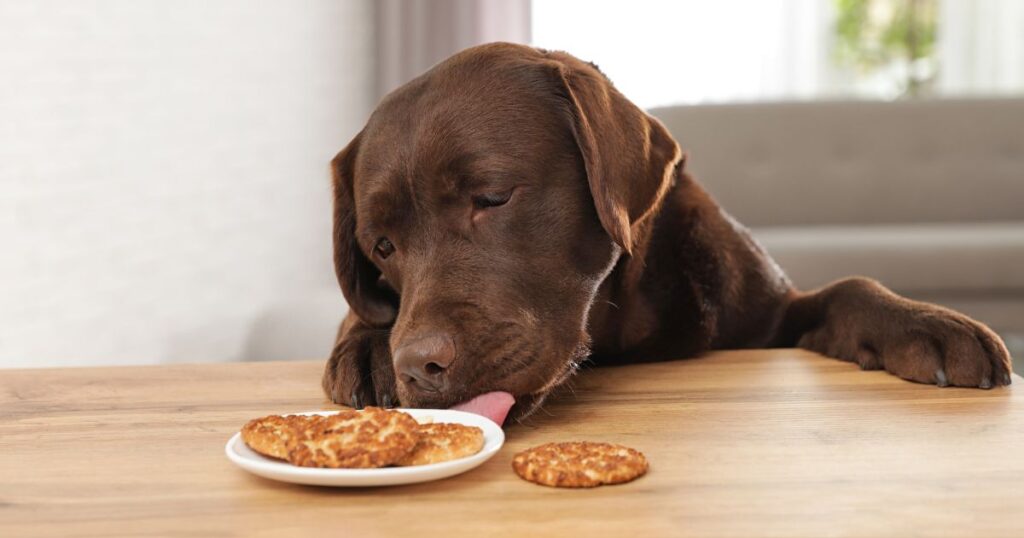
Properly nourishing a Labrador puppy is a crucial part of caring for your new furry companion. Understanding the nutritional requirements of these lively and affectionate pets is vital for their well-being. The quantity, frequency, and type of food you provide can have a significant impact on their health in the long run. When it comes to feeding Labrador puppies, starting with kibble is a common choice due to its convenience and ease of storage. The amount of food needed will vary based on factors such as age, size, and the specific type of food you choose. For example, young puppies up to three months old should be fed three to four times daily, while those between three to six months require three to five meals a day. As they mature beyond six months, transitioning to two feedings a day is typically recommended. Following proper feeding guidelines is essential for maintaining the overall well-being of your Labrador puppy. By taking into account factors like age, size, and nutritional requirements, you can ensure that your beloved pet grows up healthy and happy, enjoying a fulfilling life by your side.
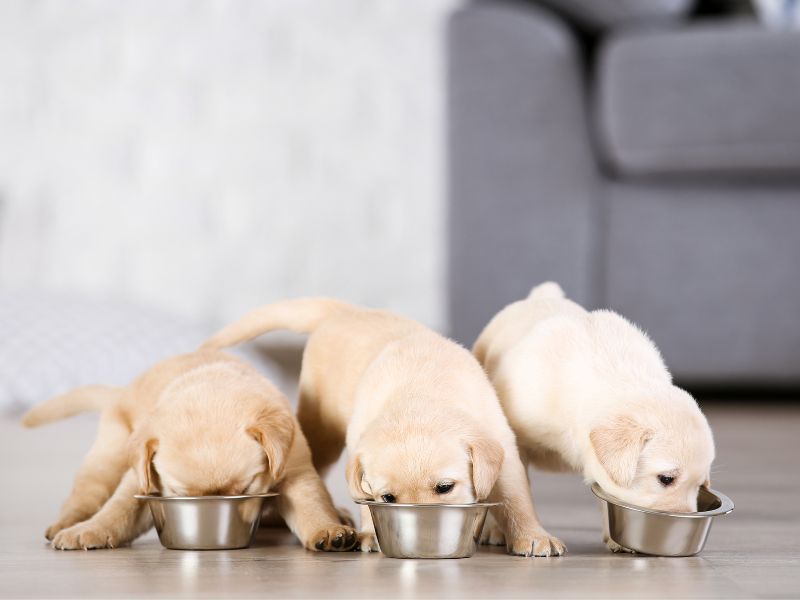
Providing nourishment to a Labrador puppy can be accomplished in various ways, such as using kibble, raw food (BARF), wet food, or homemade meals. Each feeding method has its advantages and disadvantages, making it important for owners to choose the one that best meets their puppy’s requirements. Kibble, also known as dry food, is a popular choice among Labrador puppy owners due to its convenience and balanced nutrient content. This type of food is made from ground meal shaped into dry pellets, making it easy to purchase, store, and feed to your puppy. BARF, or Biologically Appropriate Raw Food, is another option that focuses on feeding raw, uncooked ingredients. Advocates believe this diet is more natural and healthier for puppies, while opponents argue it may expose them to harmful bacteria. Wet food, available in cans and pouches, is a higher-moisture option that can be easier for puppies to chew and digest. However, it may be messier and pricier compared to dry food choices. For those who prefer to prepare their puppy’s food at home, homemade meals offer complete control over the ingredients, ensuring the puppy receives optimal nutrition. However, this approach requires a good understanding of canine nutrition and can be time-consuming. Choosing the best feeding method for a Labrador puppy can be challenging, as even experts may disagree on the ideal food. Factors like age, weight, and lifestyle should be considered when selecting the right option. Consulting a veterinarian for advice on nutrition and feeding schedules is crucial. Some top-recommended foods for Labrador puppies include Nom Nom Fresh Pet Food, Hill’s Science Diet Large Breed Puppy, Purina ONE Natural High Protein +PLUS, Ollie Fresh Pet Food, Royal Canin Labrador Retriever Puppy Food, Purina Pro Plan High Protein Chicken & Rice Formula, Orijen Puppy Large, and Blue Buffalo Life Protection Formula Large Breed Puppy. In conclusion, providing a Labrador puppy with proper nutrition requires thoughtful consideration and research. With various feeding methods and a wide selection of recommended foods, owners have plenty of options to ensure their furry companion receives the best care possible.
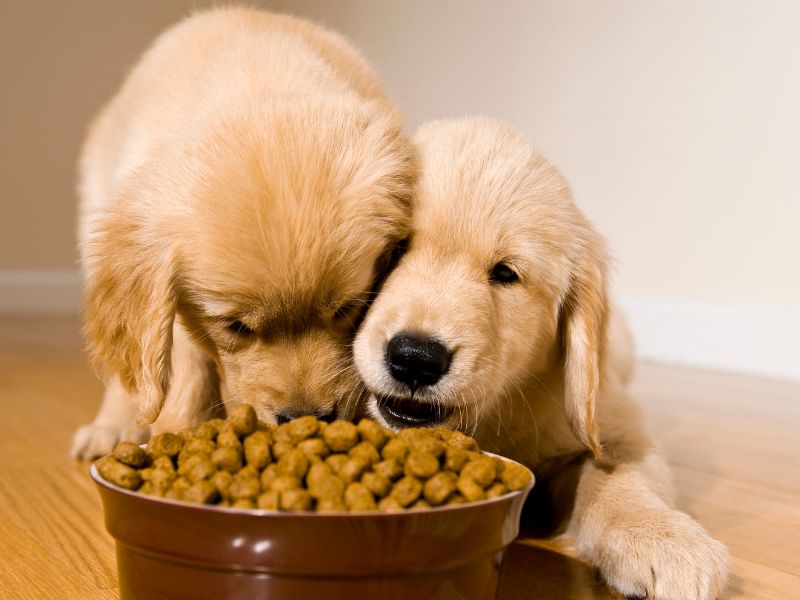
Feeding Labrador puppies with kibble is a popular choice among owners because of its convenience and balanced nutrition for growing pups. Kibble is essentially ground-up food formed into pellets and dried for easy storage. When choosing kibble for your Labrador puppy, make sure to pick a high-quality formula that is suitable for their age and nutritional needs. There are various brands that offer puppy-specific formulas to cater to the requirements of young dogs. The amount of kibble to feed your Labrador puppy will depend on their weight. Here is a general guideline based on weight: – 40-45 pound Lab: 205-230 grams per day – 50-55 pound Lab: 240-265 grams per day – 60-65 pound Lab: 270-300 grams per day It’s important to divide these daily amounts into multiple meals throughout the day, as puppies have small stomachs and need more frequent feedings. Starting with three to four meals a day for your Labrador puppy is recommended. Properly storing kibble is crucial to keep it fresh and free from dampness. Use an airtight, food-grade plastic container or tin for storing the kibble to maintain its freshness and safety for your puppy. In summary, feeding your Labrador puppy with kibble can be a practical and nutritious choice. Choose a high-quality formula, provide the right amount based on their weight, and adjust as needed for their growth and development. If you’re looking to add variety to your puppy’s diet, consider incorporating wet food, raw or home-cooked meals, supplements, and treats. Make sure to consult with your vet for personalized recommendations based on your puppy’s individual needs and dietary requirements.
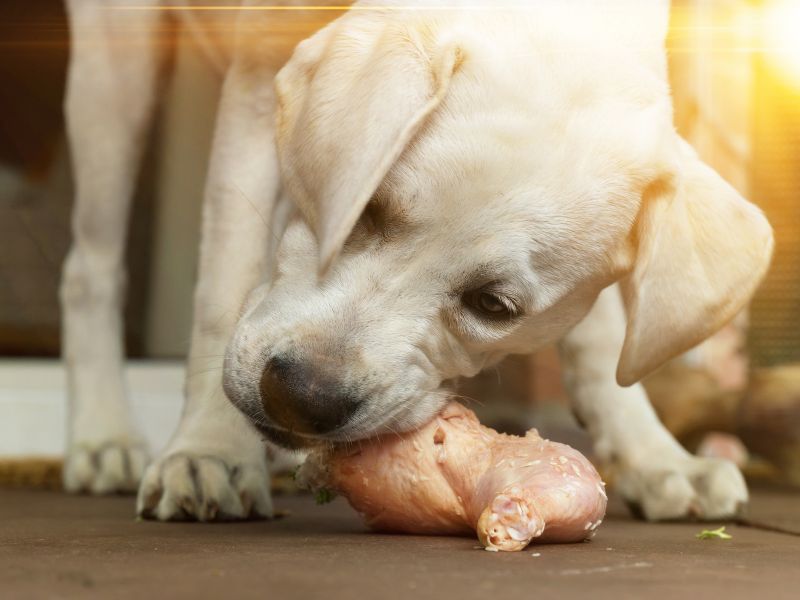
Labrador puppies over 6 months old should be fed around 2-3 times daily, with a balance of dry and wet food. It’s important to continue monitoring their growth and adjust the amount of food as needed to ensure they are getting the right nutrients for their development. Remember that individual puppies may have different appetites and nutritional needs, so it’s crucial to pay attention to their growth and adjust their feeding schedule accordingly.
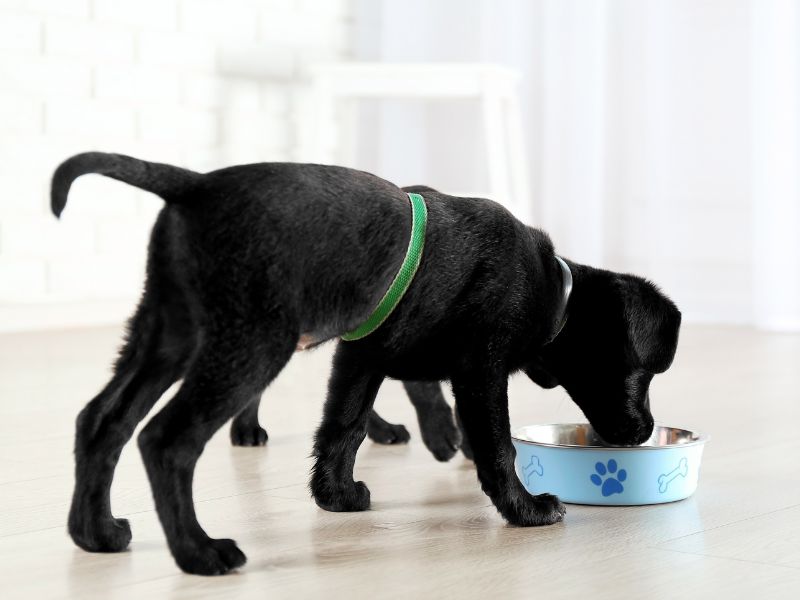
When your Labrador puppy reaches the age of 6 months, you can switch their feeding schedule to twice a day as they transition to an adult diet. It’s important to make sure their meals are providing all the necessary nutrients for their health and well-being. Overfeeding your puppy can lead to various health issues such as obesity and rapid growth, which can put strain on their bones and joints. To avoid overfeeding, follow the guidelines provided by the food manufacturer and consult with your vet to ensure your puppy’s nutritional needs are being met. Feeding a Labrador puppy requires careful attention to their needs as they grow. The following feeding chart can be used as a rough guide, but individual needs may vary based on size, age, and activity level. It’s crucial not to overfeed your puppy to prevent obesity and joint problems. Choosing the right brand of puppy food is essential for your Labrador’s overall health. Consider factors such as cost, quality, and availability when selecting a brand. Some high-quality options include Royal Canin, Wellness Complete Health, Hill’s Science Diet, and Pedigree. Research each brand and read reviews to find the best option for your Labrador puppy.
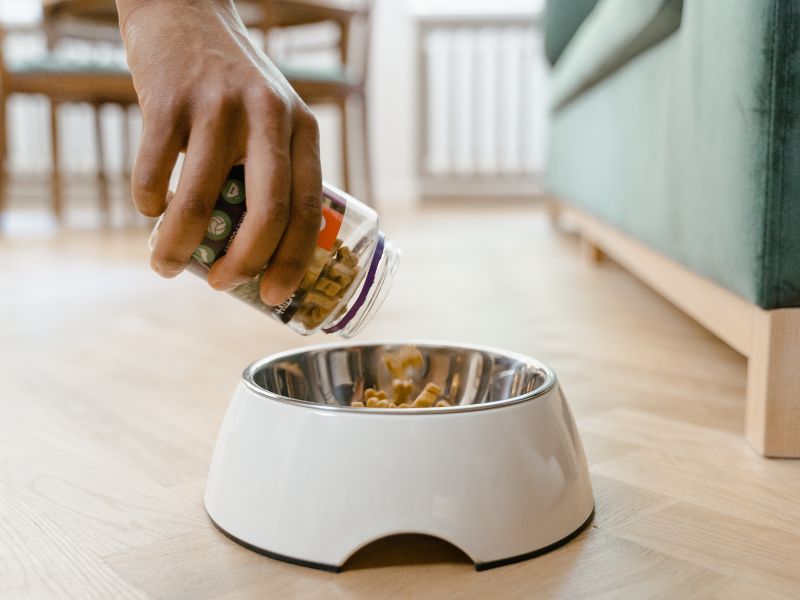
Selecting the appropriate food and water bowls for your Labrador puppy is crucial for their mealtime experience. Opt for bowls that are sturdy, easy to clean, and the right size for your pup’s age and breed. Stainless steel or ceramic bowls are recommended as they are durable and hygienic. Additionally, elevated bowls can help prevent strain on your puppy’s neck and back during mealtime. Consider purchasing separate bowls for food and water to ensure proper hydration and digestion. By taking these factors into consideration, you can create a comfortable and stress-free feeding environment for your furry companion.
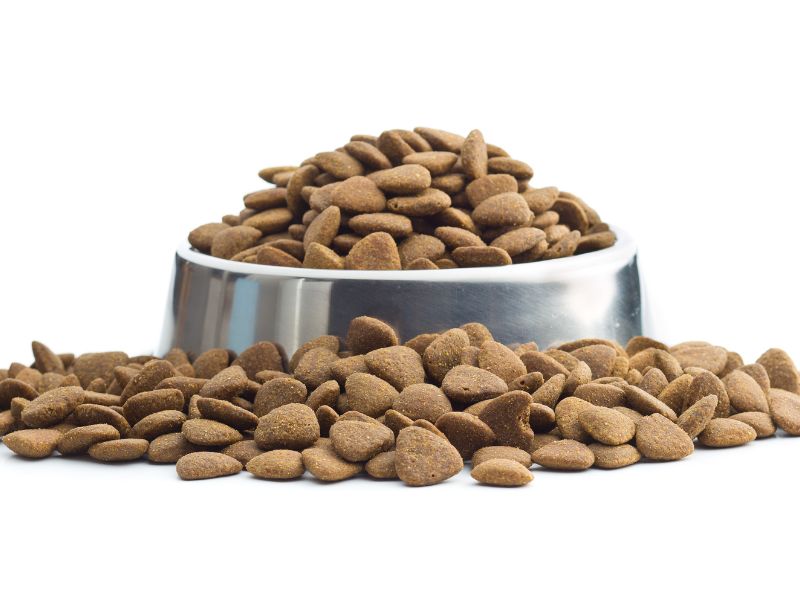
When it comes to feeding your Labrador puppy, it’s essential to follow some general guidelines to ensure they are getting the right amount of food at the right times. Here are some tips to help you establish a feeding schedule for your adorable new friend: Frequency: Labrador puppies should typically be fed four times a day in their early stages of growth. As they get older, you can reduce this to two meals a day. Make sure to provide a consistent feeding schedule to help regulate their appetite and digestion. Portion Size: When determining portion sizes for your puppy, a good rule of thumb is to provide around 200-250 grams of food per day. This amount can be divided into their designated meals throughout the day. However, it’s important to adjust portion sizes based on your puppy’s individual needs and growth rate. Consultation: If you’re unsure about how much or how often to feed your Labrador puppy, don’t hesitate to consult with your veterinarian. They can provide valuable insights and guidance on the best feeding practices for your puppy’s health and growth. By following these general guidelines and adjusting as needed based on your puppy’s individual requirements, you can ensure that your Labrador stays happy, healthy, and well-fed throughout their development. Remember, a well-fed puppy is a happy puppy!
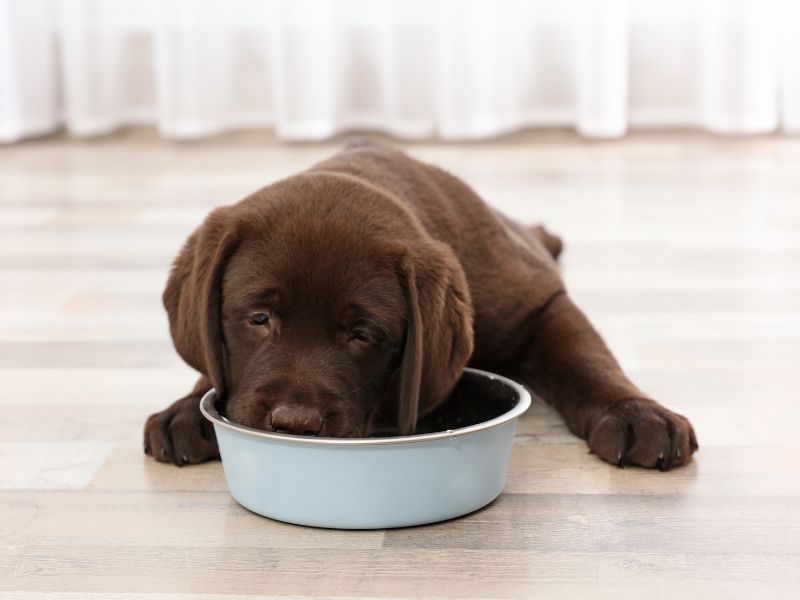
If your Labrador puppy still seems hungry after their meal, it’s important to first ensure that you are feeding them the correct amount of food based on their age and weight. If they are consistently finishing their meals and showing signs of hunger, you can consult with your vet to reassess their feeding schedule and portion sizes. It’s also helpful to provide mental stimulation and engaging activities to prevent boredom, as excessive eating can sometimes be a sign of boredom rather than actual hunger. Remember, every puppy is unique, so it’s essential to tailor their feeding routine to their individual needs to ensure they are happy and healthy.

Transitioning your Labrador puppy from puppy food to adult food is an important step in their development. This process typically occurs around 10 weeks of age for proper growth and nutrition. Before making the switch, it’s crucial to consult your veterinarian for guidance on the best timing and method for transitioning your puppy to adult food. One common approach is to gradually mix the new adult food with the remaining puppy food over a period of about a week. Start by adding a small amount of adult food to the puppy food and gradually increase the ratio each day. This gradual transition helps prevent digestive upset and allows your puppy to adjust to the new food gradually. It’s important to monitor your puppy’s reaction to the new food during this transition period. Look for any signs of digestive issues or changes in appetite, and adjust the transition speed accordingly based on your puppy’s response. By following your veterinarian’s advice and monitoring your puppy’s progress, you can ensure a smooth transition from puppy food to adult food for your Labrador.
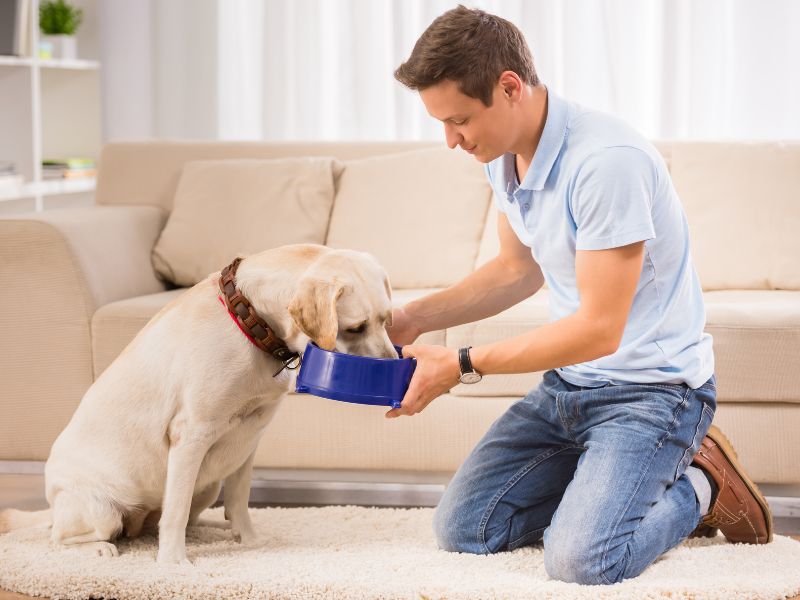
As Labrador puppies grow, their dietary needs change, requiring a transition from puppy to adult food at around 80% of their expected adult size, usually between 9 to 12 months of age. Puppy food is high in protein and calories for growth, while adult food has fewer calories for a more sedentary lifestyle. To transition your Labrador puppy to adult food, do it gradually to avoid stomach upset. A sample plan includes mixing puppy and adult food in varying proportions over several days to allow for adjustment. Monitor your puppy for any signs of intolerance and consult your vet if needed. Switching between dog food brands can be necessary for different reasons, like dietary needs or allergies. Transition slowly over a week or two to prevent digestive issues. Follow a guideline of gradually increasing the new food percentage in the mix with the old food. Adding variety to your Labrador puppy’s diet can be beneficial. Hand feeding can strengthen your bond and help with mealtime anxiety. Using healthy treats during training can reinforce positive behaviors while offering diverse flavors and textures. Remember to limit treat intake to a small portion of their daily caloric needs. Incorporating hand feeding and treats into training sessions can promote a healthy appetite, balanced nutrition, and a strong bond between you and your furry friend.


